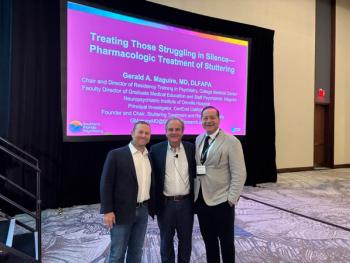- Vol 32 No 8
- Volume 32
- Issue 8
Contemporary ECT, Part 2: Mechanism of Action and Future Research Directions
Simply telling patients “we don’t know how ECT works” neglects our abundant knowledge of what this treatment does. The authors review biological actions of ECT and discuss future directions for research.
[[{"type":"media","view_mode":"media_crop","fid":"32074","attributes":{"alt":"ECT for depression","class":"media-image media-image-right","id":"media_crop_1210448114029","media_crop_h":"0","media_crop_image_style":"-1","media_crop_instance":"4153","media_crop_rotate":"0","media_crop_scale_h":"147","media_crop_scale_w":"125","media_crop_w":"0","media_crop_x":"0","media_crop_y":"0","style":"float: right;","title":" ","typeof":"foaf:Image"}}]]Electroconvulsive therapy (ECT) continues to be a vital treatment for severe depression and a few other psychiatric diagnoses. Its more widespread use has been limited primarily by the unwarranted stigma attached to the procedure. In addition, critics often cite a lack of knowledge about its mechanism of action as a reason to eschew its use. Here we review some of the knowledge base of ECT’s biological actions and discuss future directions for ECT research.
Mechanism of action
Decades of research in both animal models of ECT (referred to as electroconvulsive shock, or ECS) and clinical trials in humans have contributed to a vast evidence base of neurobiological changes associated with induced seizures. Undoubtedly, the biological events ultimately leading to relief from depression with ECT involve a cascade of effects related to molecules, cells, and circuits. While various researchers have focused primarily on one of these neurobiological domains, there is no currently articulated theory of the mechanism of action of ECT in depression that incorporates events at all 3 levels. It is likely that many of the myriad observed changes are epiphenomena not essential to the therapeutic effects of ECT.
Many technologies have been applied to the study of the neurobiological effects of ECT or ECS, including single photon emission CT, positron emission tomography, functional MRI (fMRI), magnetic resonance spectroscopy (MRS), EEG, body fluid chemical analysis (blood, urine, cerebrospinal fluid) and, in animals, histological examination and molecular genetic assays. The main theories of mechanism of action of ECT in depression can be classified as follows: neurotransmitter, neuroendocrine, anticonvulsant, neurotrophic, and neural connectivity hypotheses.
The neurotransmitter theory of action of ECT arises from long-standing interest in the monoamines (serotonin, dopamine, norepinephrine) and other neurotransmitters, such as GABA and glutamate, in biological theories of the etiology of depression. Animal studies have shown consistent effects of ECS on monoamine neurotransmitter functioning, such as enhancement of serotoninergic transmission; results have been
The neuroendocrine
The anticonvulsant theory of ECT action arose from the observation that seizure threshold often rises and seizure duration shortens over a course of ECT, leading to the hypothesis that the inhibitory brain process associated with the progressive rise in seizure threshold is also responsible for depression relief. Support for this comes from EEG and cerebral blood flow studies that demonstrated suppression of neural activity (mostly in the frontal lobes) after a course of ECT, which
The most recent conceptualizations of ECT mechanisms involve newer technologies for investigating cellular morphological changes, termed “neuroplasticity,” in animals, and “neural connectivity” in humans. The neuroplasticity (or neurotrophic) hypothesis of ECT mechanism holds that morphological changes, such as neurogenesis, gliogenesis, or alterations in dendritic or axonal arborization of existing neurons, are critical to the
Brain imaging
Remarkable brain structural detail can now be imaged with high–magnet-strength MRI. Such imaging has recently been applied to ECT patient populations at baseline (in the ill state, before ECT) and during and after a course of ECT. Findings indicate increased gray matter volume after ECT in the hippocampus, subgenual cortex, and amygdala.9-12
It may be that baseline brain morphology is abnormal in severely depressed patients, and that ECT-induced neuroplasticity results in a return to normal size and morphology of structures such as the hippocampus and amygdala.
There have been several attempts to elucidate neurotrophic ECT mechanisms using MRS.
Quantitative EEG and fMRI have only recently been applied to ECT populations.
In an fMRI study of 6 patients treated with ECT,
While we await a definitive understanding of the biological changes underpinning the mechanism of action of ECT, there is no need to be defeatist. Simply telling patients “we don’t know how ECT works” neglects our abundant knowledge of what this powerful treatment does. As
Future directions
ECT research will continue to focus on refining aspects of technique and personalizing ECT type and schedule, as well as further elucidating its mechanisms of action. Technical refinements are aimed at preserving antidepressant efficacy while increasing cognitive tolerability. Techniques to more precisely target particular brain structures or areas for seizure initiation and/or to limit the spread of the seizure are under development.
Disclosures:
Dr Kellner is Professor in the department of psychiatry at the Icahn School of Medicine at Mount Sinai, Chief of Geriatric Psychiatry for the Mount Sinai Health System, and Director of the ECT Service at the Mount Sinai Hospital in New York. Dr Rasmussen is Professor in the department of psychiatry and psychology at the Mayo Clinic in Rochester, Minn. The authors report no conflicts of interest concerning the subject matter of this article.
References:
1. Baldinger P, Lotan A, Frey R, et al. Neurotransmitters and electroconvulsive therapy. J ECT. 2014; 30:116-121.
2. Sanacora G, Mason GF, Rothman DL, et al. Increased cortical GABA concentrations in depressed patients receiving ECT. Am J Psychiatry. 2003;160:577-579.
3. Michael N, Erfurth A, Ohrmann P, et al. Metabolic changes within the left dorsolateral prefrontal cortex occurring with electroconvulsive therapy in patients with treatment resistant unipolar depression. Psychol Med. 2003;33:1277-1284.
4. Merkl A, Schubert F, Quante A, et al. Abnormal cingulate and prefrontal cortical neurochemistry in major depression after electroconvulsive therapy. Biol Psychiatry. 2011;69:772-779.
5. Pfleiderer B, Michael N, Erfurth A, et al. Effective electroconvulsive therapy reverses glutamate/glutamine deficit in the left anterior cingulum of unipolar depressed patients. Psychiatry Res. 2003;122:185-192.
6. Haskett RF. Electroconvulsive therapy’s mechanism of action: neuroendocrine hypotheses. J ECT. 2014;30:107-110.
7. Farzan F, Boutros NN, Blumberger DM, Daskalakis ZJ. What does the electroencephalogram tell us about the mechanisms of action of ECT in major depressive disorders? J ECT. 2014;30:98-106.
8. Bouckaert F, Sienaert P, Obbels J, et al. ECT: its brain-enabling effects: a review of electroconvulsive therapy–induced structural brain plasticity. J ECT. 2014;30:143-151.
9. Dukart, Regen F, Kherif F, et al. Electroconvulsive therapy-induced brain plasticity determines therapeutic outcome in mood disorders. Proc Natl Acad Sci U S A. 2014;111:1156-1161.
10. Nordanskog P, Dahlstrand U, Larsson MR, et al. Increase in hippocampal volume after electroconvulsive therapy in patients with depression: a volumetric magnetic resonance imaging study. J ECT. 2010;26:62-67.
11. Tendolkar I, van Beek M, van Oostrom I, et al. Electroconvulsive therapy increases hippocampal and amygdala volume in therapy refractory depression: a longitudinal pilot study. Psychiatry Res. 2013;214:197-203.
12. Joshi SH, Espinoza RT, Pirnia R, et al. Structural plasticity of the hippocampus and amygdala induced by electroconvulsive therapy in major depression. 2015 Mar 5; [Epub ahead of print].
13. Abbott CC, Gallegos P, Rediske N, et al. A review of longitudinal electroconvulsive therapy: neuroimaging investigations. J Geriatr Psychiatry Neurol. 2014;27:33-46.
14. Michael N, Erfurth A, Ohrmann P, et al. Neurotrophic effects of electroconvulsive therapy: a proton magnetic resonance study of the left amygdalar region in patients with treatment-resistant depression. Neuropsychopharmacology. 2003;28:720-725.
15. Ende G, Braus DF, Walter S, et al. The hippocampus in patients treated with electroconvulsive therapy: a proton magnetic resonance spectroscopic imaging study. Arch Gen Psychiatry. 2000;57:937-943.
16. McCormick LM, Yamada T, Yeh M, et al. Antipsychotic effect of electroconvulsive therapy is related to normalization of subgenual cingulate theta activity in psychotic depression. J Psychiatr Res. 2009; 43:553-560.
17. Perrin JS, Merz S, Bennett DM, et al. Electroconvulsive therapy reduces frontal cortical connectivity in severe depressive disorder. Proc Natl Acad Sci U S A. 2012;109:5464-5468.
18. Abbott CC, Lemke NT, Gopal S, et al. Electroconvulsive therapy response in major depressive disorder: a pilot functional network connectivity resting state fMRI investigation. Front Psychiatry. 2013;4:10.
19. Beall EB, Malone DA, Dale RM, et al. Effects of electroconvulsive therapy on brain functional activation and connectivity in depression. J ECT. 2012; 28:234-241.
20. Christ M, Michael N, Hihn H, et al. Auditory processing of sine tomes before, during and after ECT in depressed patients by fMRI. J Neural Transm. 2008; 115:1199-1211.
21. Andrade C. A primer for the conceptualization of the mechanism of action of electroconvulsive therapy, 1: defining the question. J Clin Psychiatry. 2014;75:e410-e412.
22. Andrade C. A primer for the conceptualization of the mechanism of action of electroconvulsive therapy, 2: organizing the information. J Clin Psychiatry. 2014;75:e548-e551.
23. Nahas Z, Short B, Burns C, et al. A feasibility study of a new method for electrically producing seizures in man: focal electrically administered seizure therapy [FEAST]. Brain Stimul. 2013;6:403-408.
Articles in this issue
over 10 years ago
Introduction: Impulsivity-A Transdiagnostic Traitover 10 years ago
Impulse Control, Impulsivity, and Violence: Clinical Implicationsover 10 years ago
Impulsivity and Suicide Risk: Review and Clinical Implicationsover 10 years ago
Implications of Impulse Control Disorder in Parkinson Diseaseover 10 years ago
From Impulsivity to Addiction: Gambling Disorder and Beyondover 10 years ago
Telepsychiatry: Watching Your Back While Staying in the Blackover 10 years ago
Tai Chi Is a Biological Treatment for Depressionover 10 years ago
Psychopharmacological Options for Treating ImpulsivityNewsletter
Receive trusted psychiatric news, expert analysis, and clinical insights — subscribe today to support your practice and your patients.


















